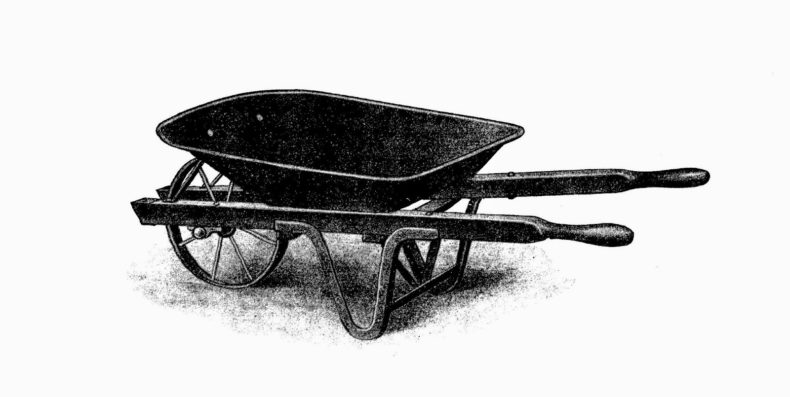
I attended a repatriation of artifacts and bones under Native American claim recently. The remains of 41 people and the artifacts buried with them, retrieved from an archaeological collection, went back in the ground.
There’s not a lot I can write in detail. Returning the dead of a millennia-old village is an involved procedure and I did not take notes. It was shovels and damp soil, trenches deep enough they should not be dug up again.
Repatriation materials had been transported to the site in cardboard office boxes prepared by the museum they came from. Where I expected to see a jumble of bubble wrap and masking tape, objects had been slid into neat cotton sacks, tied closed with cotton strips. They were not nested for transport, but given their own sacks of different sizes, each bowl and jar, each small purse of beads with a draw string tied closed. Soft cotton pads had been placed between more fragile items. It looked like a burial in boxes, given back in the gentlest custom the museum could devise.
When the objects were pulled out, it felt as if the dead were being freed from science. They were themselves again.
Native Americas have myriad burial rites, but re-burials are new. Bones and artifacts have been unearthed and sent by boxcar and freight to far away places where they have sat unattended or been watched by microscopes for decades or centuries. These are not just a dead people and their offerings, but travelers come home. A new ritual is needed.
NAGPRA, the Native American Graves Protection and Repatriation Act of 1990, mandates the return of all grave goods and the bones that came with them. A friend who attended the repatriation, a retired government archaeologist and former museum curator of Pueblo lineage, told me that these repatriation laws have barely been complied with. Museums have put little manpower into returning artifacts while there is mild interest among the tribes to get it all back. Some things, though, are sought after, like this village.
My friend said he’d started the process in 2011 to get the former occupants of this village out of storage, where they’ve been since 1959. His words were halting when he recited the number of years, not sadness I think, but relief, clarity, poignancy. It was finally happening.
Not every touch at the repatriation was tender. Some pieces were sprinkled out of the bottom of cotton sacks. Some were placed neatly, cradled in the hand for a moment by a man speaking one of the languages of the nations, talking over certain artifacts, taking note of something he saw, maybe pointing it out to the rest of us before nesting it into the ground.
Some acts were procedural, skulls and pots filled with soil so they would not collapse under the weight of burial.
While traveling in the Northwest some 30 years ago, I stumbled onto a wood-plank garage in the forest behind the University of British Columbia. I peeked in through the cracks and saw half-rotted totem poles laid like timbers. There was a smudged and broken window with enough glass missing I could look through and see a bentwood box close enough I could have touched it. Faint red paintings were visible on the lidded box beneath a sheen of oil and dust. Collections of anthropologists from tribes up the coast.
That experience stuck with me. Where was home for these items? Familiar to some people, but slowly drifting out of memory, they might never get back. Were they bound for display in a museum with tones hushed as if in apology? Would they rot here in the woods into splinters and frass? Looking in through that broken window, I thought they may never see home again, like finding a group of refugees huddled in a dark space. A moment of eye contact and I’d forever wonder what happened to them.
I’ve watched sites in the Southwest empty until almost every last chip of potsherd is gone. Not to mention early diggers and scientists loading their museums in the 18th and 19th centuries. Parts of the land have been raped for their history. Thus, NAGPRA, which has been painfully slow and barely complied with. But what is supposed to be done when there’s not even a ritual for their return, neither in museums nor among the tribes?
What I saw at this repatriation was a ritual forming, a solution devised, objects delivered with care to a trench where a Native American man on his knees put them back where they came from.
Shovels dug into the work; wheelbarrows and grunts filled the trenches. The smell of smoke, piñon and juniper, dried and crackling. Tarps for the rain, and wet sage against our pants as we left the site, the ground smooth, the way it had been found.
This is all I can tell you.
I would very much like to discuss with you a photograph my great grandfather took of a pair of mummies from an 1891 Grand Gulch expedition (I have done a lot of research on this to come to that conclusion). I have approached numerous museums, schools, and anthropologists about this photo. It would be wonderful if someone would want to come alongside me with the same passion I have for the people in the photograph. There whereabouts are unknown. Let me know.
Kathy, sounds like quite a photograph. Was that the McLoyd and Graham expedition?
Moving. I teared up thinking about it.